There’s been racing at Casterton since the 1850s and the track now claims to have Australia’s only live hedge jumps course. It’s set in a natural amphitheatre so we were here for the vintage hedges
My experience at the races
I came to Casterton for its hedge. Well there are a few hedges, actually, and Casterton racecourse reckons it has the only racing in Australia with live hedges on the course. This type of racing is pretty common back home in the UK, but over here it’s rare, and it may not make for an orthodox Vintage Victoria post, but I reckon these hedges at Casterton are vintage all right.
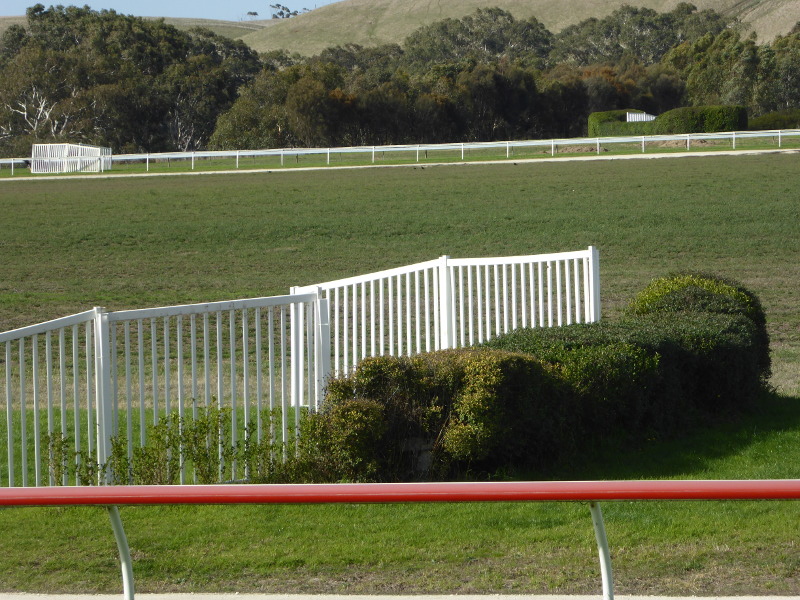
There seems to be a lot of local pride in the racecourse, and judging by the crowd on this Casterton Cup day in May, it looked as if most of the 1600 or so population had made a day of it.
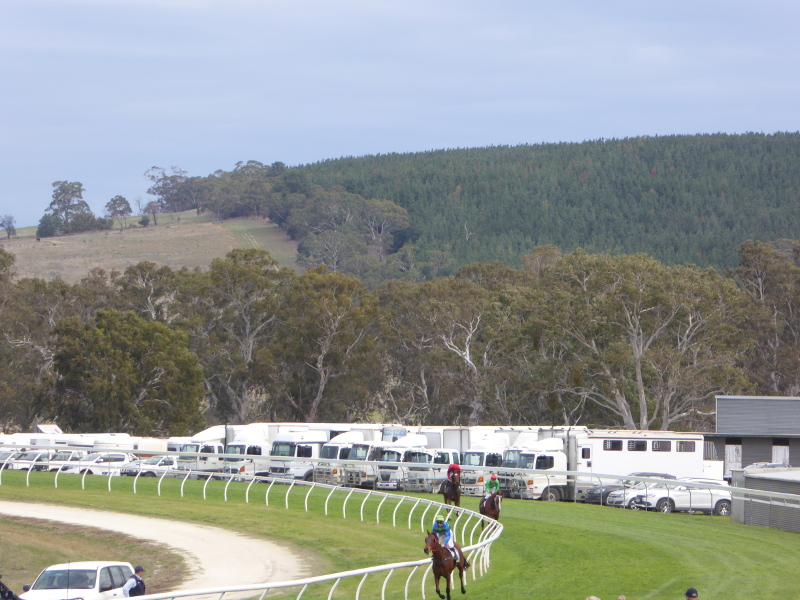
It’s certainly a beautiful setting, with two rivers forming part of the boundary of the course, and a hill beside the finishing line, which makes it into a natural amphitheatre, so in that respect reminded me a little of Hanging Rock Racecourse.
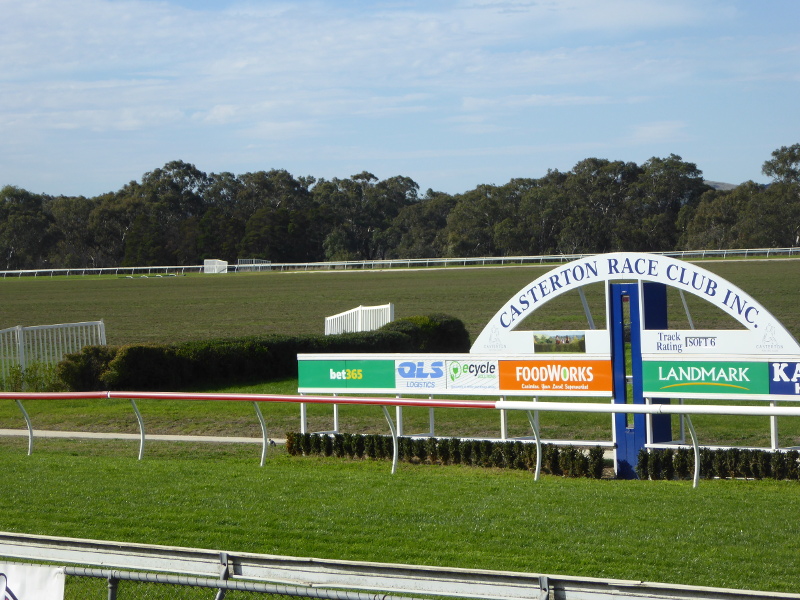
The rivers obviously carry great significance locally, too, not only because they have flooded in the past, but also because the jump course runs very close to the water (see the photo on this website with an aerial view of the track). And each time the steeplechasers ran past that distant point by that curve in the river, the commentator made some remark about water and land joining, with the crowd responding with a whoop and a cheer. Maybe someone can tell me exactly what he did say at this point?
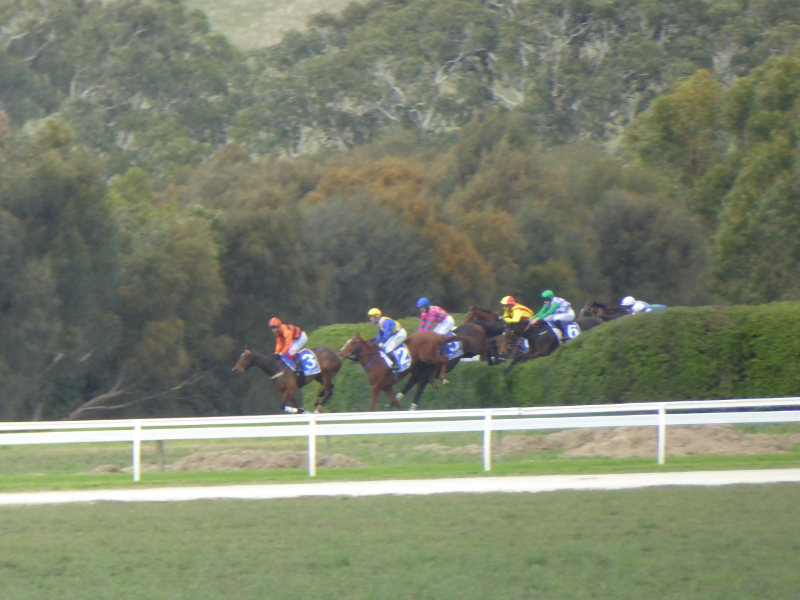
Casterton has got rid of most of its vintage infrastructure, though. The oldest things – other than those hedges – looked like the winning numbers, put up after the results were declared for each race.
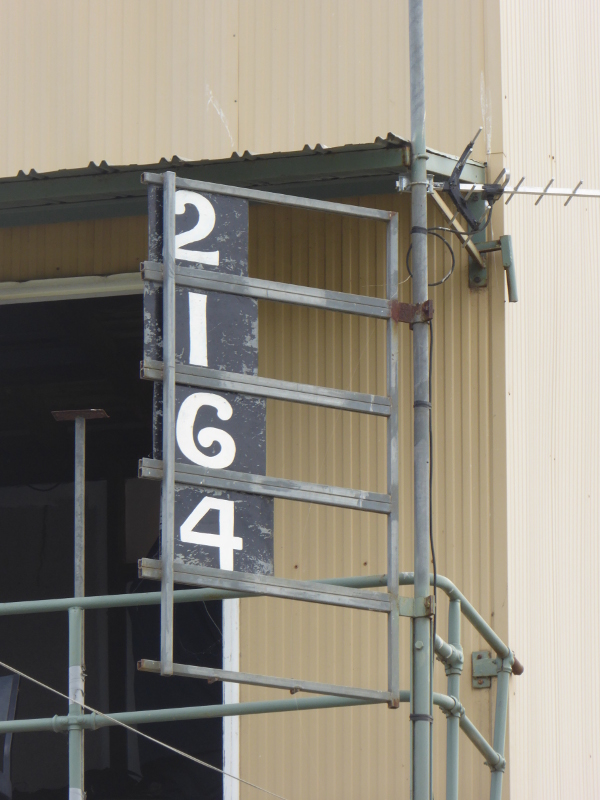
And put up, I must say by one of the best-dressed gentlemen at the course that day. Very vintage outfit, if ever I saw one.
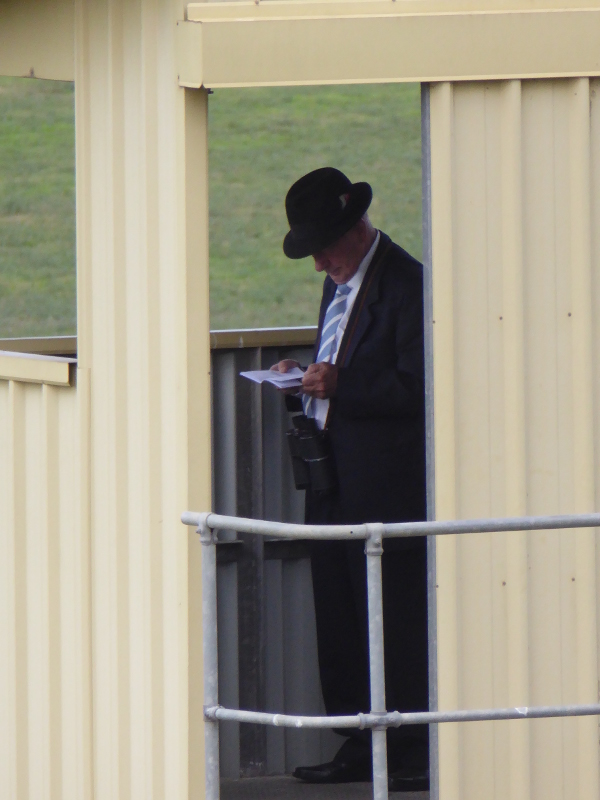
There was a lovely vintage grandstand – or maybe a vintage clubhouse – here once, as I found in one of the photos up on the wall of the dining room. That picture dates from 1928, so I wonder when it was replaced? Maybe in the 1950s refurb of the course?
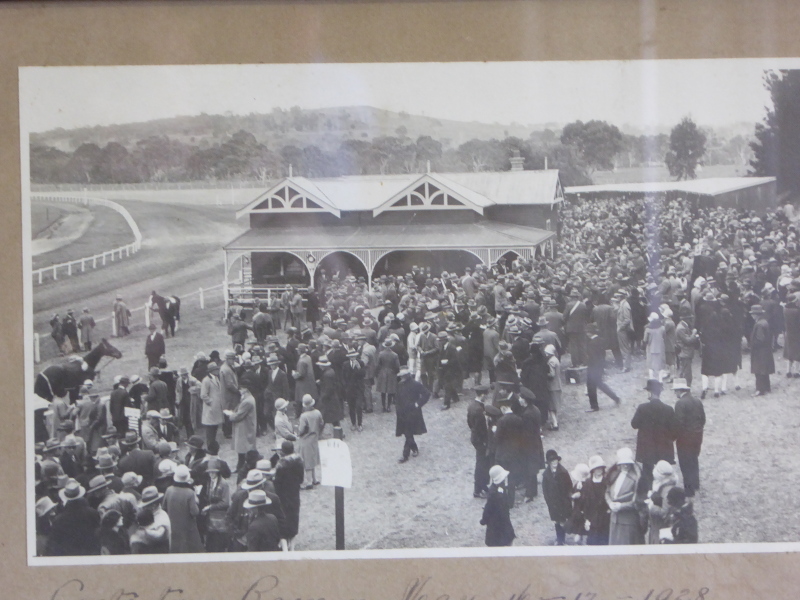
Most people watch the racing from the path and terrace half way up the hill – it seems to be the handiest spot to grab another beer in between races. The corrugated iron ‘grandstand’, which might be a 1960s or 70s vintage at best, hosted all the Fashion in the Field events through the afternoon.
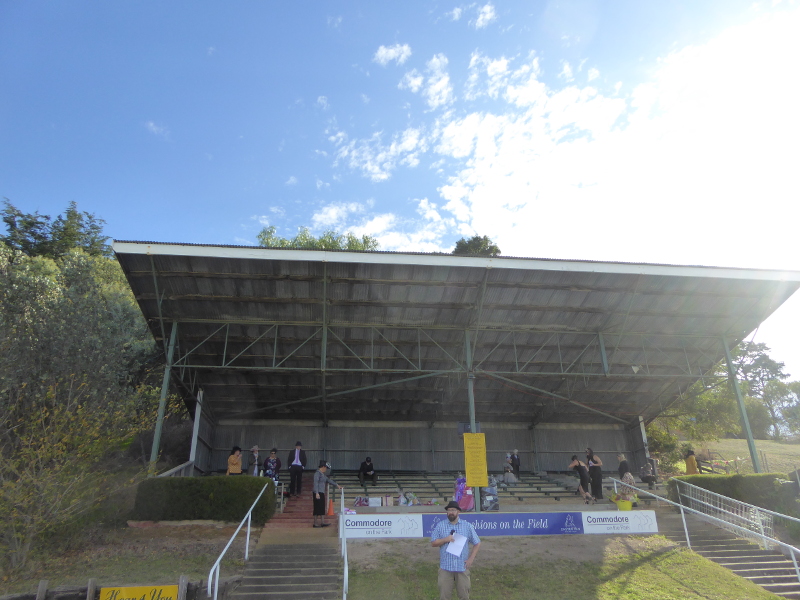
These are a great feature of country racing in Australia. There are men’s as well as women’s events (and kids), though I fancy it is the ladies who take the whole thing a tad more seriously.
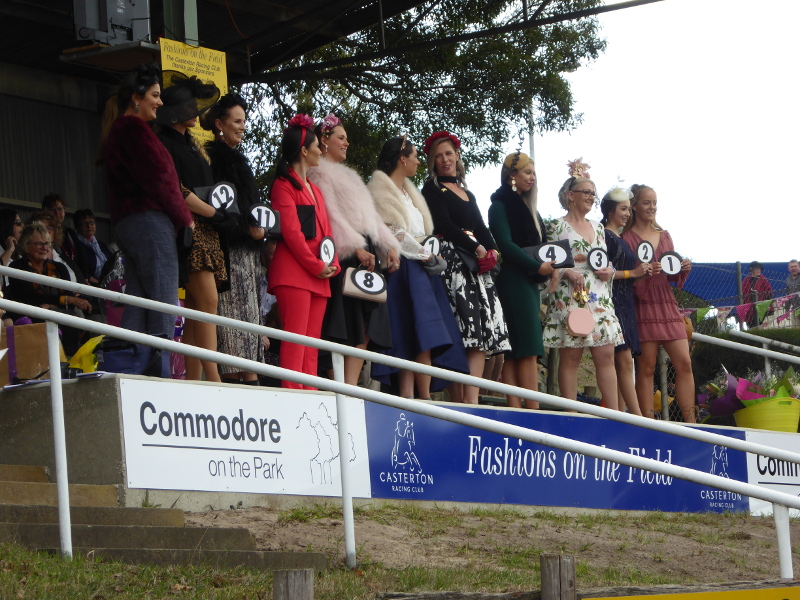
And I was struck again by the vintage photos back in the dining room, where pretty well every member of the 1900 and 1935 committees – all men of course in those days – would have won Best Dressed Man in 2019 if they had competed.
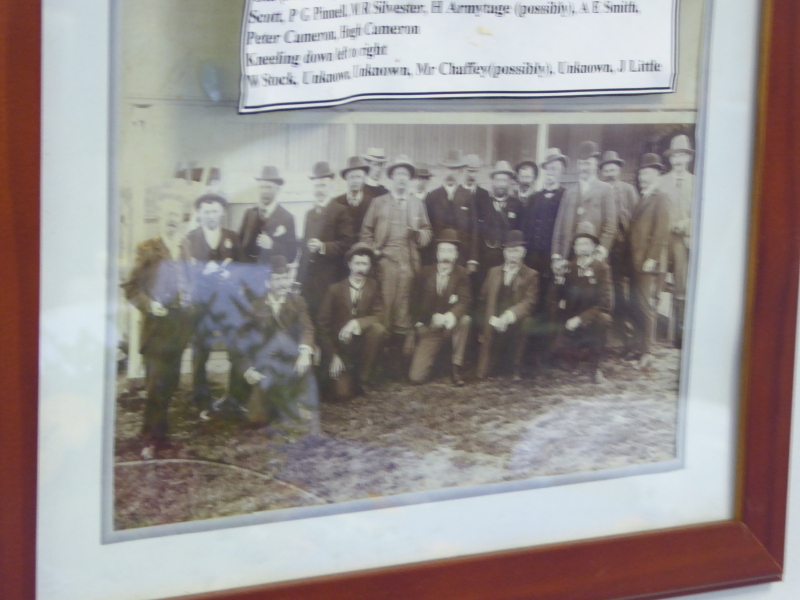
I couldn’t resist a quick chat with the compere for the afternoon, not because I wanted to enter the Fashion parade, but because he had as his tipster for the afternoon, a gentleman from Yorkshire (Barnsley in his case). Danny has connections, it seems, with the Casterton Racing Club President, so he’ll be back for the next meets, but I was intrigued to hear that he had also come across another Yorkshireman that afternoon – shame we couldn’t have had a Yorkshire group photo, so far from home in deepest western Victoria.
My interest in all the old photos around the dining room caught the eye of two local gents who were sitting right under one of the pics I wanted to take. Sean and Kevin struck up conversation, and showed me round the place a bit.
Sean is a bit of a racing historian himself, and seems to be as addicted to the Trove website as I am, so if you’re after course records (anywhere across the State, I think) or stories of champion horses from the past, he’s your man. He also promised to take me round the Flemington Racing History Museum one day, which is an offer I will definitely take up when I take Vintage Victoria to Australia’s Racing HQ.
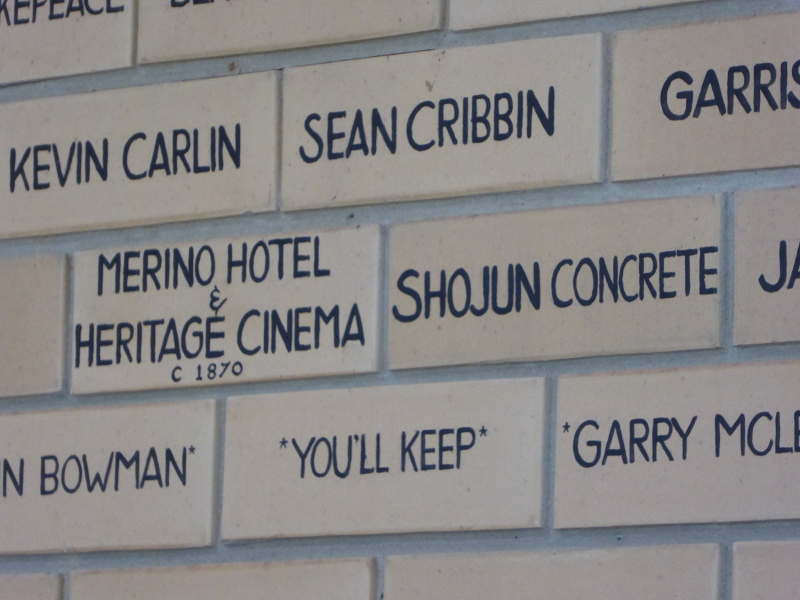
Sean and Kevin also took me down to the Casterton Racing Club bar, where for $10, you can get your name on a brick in the wall for perpetuity (well until they take down that building in any case). These two gents are up there, and I got intrigued by the stone right under their names, which might need a Vintage Victoria trip to investigate – is there really a vintage cinema in the nearby town of Merino??
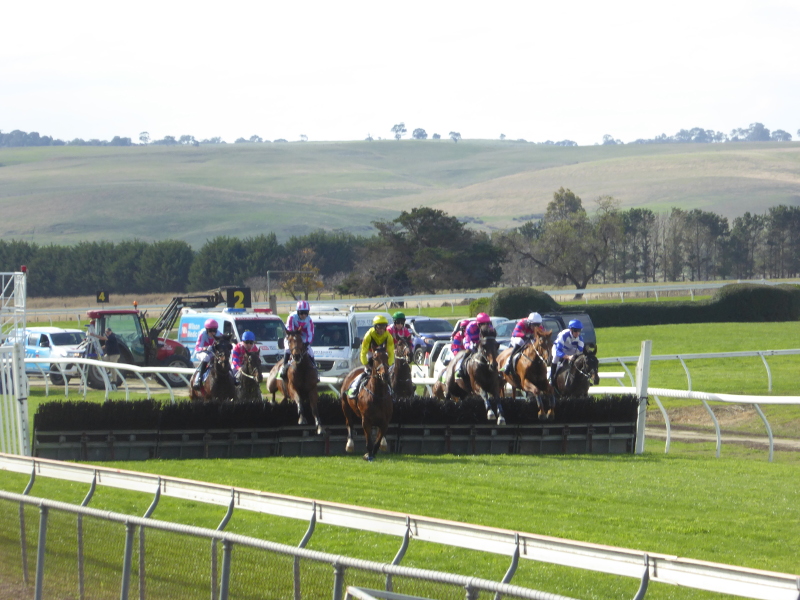
As usual, my betting exploits were hopeless, so I quit while I was behind, after losing in the big Casterton Cup race. But it was lovely to see a mix of racing, with flat, hurdles and those live hedge steeplechases. No horse injuries today, thankfully, just a couple of jockeys who’ll have sore bums on Monday morning after falling in the hurdles event.
But for all that jump racing originated in the awful English tradition of fox-hunting, it is a wonderful spectacle to watch, and that high hedge on the far side at Casterton gave me the best shots of the day at the races.
Practicalities
Course is 2kms from the town, well signposted off the Glenelg Highway to the left if you are driving towards South Australia.
$15 entrance on Casterton Cup day.
History and stories from Casterton racecourse
Most of the current racing websites all name 1861 as the year the first hurdle race was run at Casterton, and 1862 the first steeplechase (over those live hedges). But Trove has an article from the Portland Guardian reporting on hurdle races as early as 1857. And by 1859 there were reports of steeplechases ‘over eight four-foot high fences’. So I think the 1861/2 dates come from the year the Casterton Racing Club was formally set up. I guess racing at Casterton before that was a more informal affair.
Actually, the first reference to Casterton Races that comes up in the Trove database is from Boxing Day 1854. “The day passed off most agreeably, and perfect harmony prevailed,” claimed the Portland Guardian, bizarrely reporting on the meeting some two weeks later.
By 1860, with changes in the people in charge at the racecourse and the formation of the Racing Club on the horizon, the Portland Chronicle hoped that Casterton Races would continue, “as they are almost the only amusement in the bush.”
In trying to find some source for when the ‘live hedge’ was first used at Casterton, I was intrigued by an article from 1882, which talked about concerns over the ‘logs’ brought in for the steeplechase fences, so that didn’t sound too much like a ‘live hedge’…
And there were complaints at that time that the grandstand didn’t have good enough views of the whole racecourse, meaning the horses were out of sight for a chunk of the races. So by 1883 a new stand had been built – was that the one still showing in the vintage photograph up in the dining room today, or was that one the result of 1920 improvements?
Basically, though, as with racegoers in 2019, the best views of the whole course came from vantage points half way up the hill that banks up beside the track, so that might be why a grandstand was not a priority at Casterton. Reports from the 1930s have the grassy slopes dotted with beds of chrysanthemums, of which there is no sign now in 2019.
Early reports from Casterton found “a goodly number of the fairer sex graced the ground with their presence.” So this has never been a male-dominated day out, and 2019 was no different from 1919 or 1869 for that matter. A day at the races was always a chance to show off your wardrobe, and in the 1930s, there was much fox fur and skunk fur on display among the ladies: not much of that on show today, though…
The Hamilton Spectator correspondent often repeated the line that he found Casterton racecourse to be the ‘best appointed and prettiest country racecourse in the colonies’.
But correspondents from the big cities were occasionally dismissive. The Sydney Sportsman newspaper of 13 May 1908, was not very impressed by the quality of the horses racing at Casterton, noting that one which had done nothing in Melbourne even carrying minimum weights, then went on to win that year’s Casterton Cup, the show event here.
I found no major incidents or dramas around Casterton Racecourse, but there was the occasional jockey injury (and even two fatalities), or spectator accident which saw a few lines in local papers. I did like some of the stories of alleged cheating, though, with an appeal against the winner of the Steeplechase in 1910 being on the grounds that the horse skipped a fence over on the far side by the river (the appeal was lost, by the way).
The Weekly Times in Melbourne interviewed Racing Club member John Little for a feature on Casterton in 1935. He had over 60 years of experience of racing at Casterton, and recounted how in early days before the course was fenced, there was no way to charge for entry, and that many spectators were on horseback themselves and would follow some of the cross-country races from behind, causing a few mishaps at some of the outlying parts of the course.
For a few years, there was a special train laid on to bring spectators to the town for race day. But in 1911, it was so delayed that the train driver kindly stopped at a point near the race track so that passengers wouldn’t miss the first race. Can’t imagine that happening on a V-Line special! Pity the poor racegoers who needed first to go into town to book their accommodation for the night, and probably missed a couple of races: The local newspaper called on the Casterton Racing Club to hold an inquiry into the whole incident…
As news from the war in Europe and Africa became more and more grim, local farmers from Casterton began to do their bit, one auctioning off a bag of flour in 1915, another offering a sheep for sale during a race meet to raise funds for wounded soldiers, and the Racing Club itself gave all the proceeds of one fixture to the Red Cross.
In February 1917, the Bendigo-based aviator Basil Watson put on a display of his flying skills over Casterton racecourse. This would have been shortly before he died in an accident over Port Phillip Bay in early April the same year. But I loved his passion and entrepreneurial skills, too, as the Casterton News pointed out that Mr Watson was to offer Australian ‘Air Mail’ postcards for sale, and planned to fly them to Melbourne Airport (presumably at Essendon?) himself. Afternoon tea was laid on at the racecourse and the Casterton Brass Band performed. Must have been a morale-lifting afternoon in the midst of World War One.
There was a brief hiatus in racing at Casterton in the early 1950s, while the whole track was redesigned to its current form – and probably this will be when those vintage live hedges were introduced. Six horses had fallen in one day at a meet in 1951, which resulted in calls for a complete renovation of the course.
People linked to this place
John Little would have been a good person to highlight here with his 60 years of involvement in the course.
But I was also intrigued by Jim Hanlon – an Irish immigrant who came to Australia in the 1850s as a baby. By age 10, he had ridden in his first horse race, and when a jockey didn’t show up for a race he had a horse in at Coleraine some 70 plus years later, he put on the silks and rode it himself. He was still training winners at Casterton in 1939 at the age of 85. He died in 1940.
If anybody has any more information or stories on Jim, I’d love to hear from you…
What are your experiences and stories from a day at Casterton Races?
Anybody got nice memories of days out at Casterton races? Were those steeplechase live hedges always like they are now, or have things changed over the years?
When was that corrugated iron grandstand built? And when did they get rid of the beautiful vintage clubhouse?
Any other stories from your own days out at Casterton Races, just leave them in the box below and we can add them to the post.
Other links and writings on Casterton racecourse
The Casterton & District Historical Society used the same Trove source as me to find news of racing at Casterton dating back to 1854. They have the articles scanned in this piece.
There’s a couple of nice photos from 1914 of the racecourse on the history page of this Casterton website.
This horse racing website has a drone photo showing the whole racecourse below, and it’s possible to see just how close the steeplechase track runs to the river on the far side of the track.
The Herald Sun covered the floods which led to Casterton Races being cancelled in 2016.
The Weekly Times had a photo album from those 2016 floods. Don’t miss photo 66 of the racecourse…
Coffee before the off or to drown your losses?
Mother Goose Pantry did me an excellent coffee and date scone in the Casterton high street. It’s always nice to check out the quality before getting to the course, especially at Casterton where there was no trendy espresso van and most spectators seemed to be seeking out alcohol rather than tea or coffee. Coffee at Mother Goose was from Bricks & Mortar roasters, and they were clearly tuned into the racecourse, selling the racebook with coffee, which gave me a bit of insight before I got to the course (not that that helped me win any money as usual).

